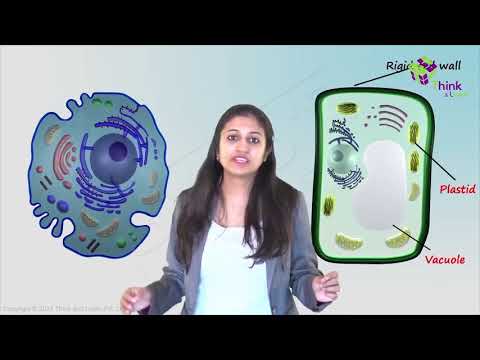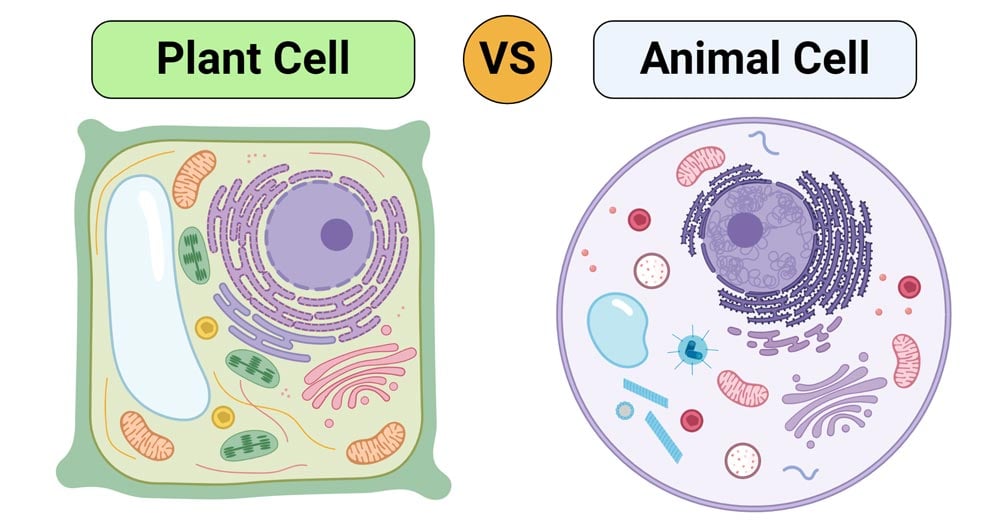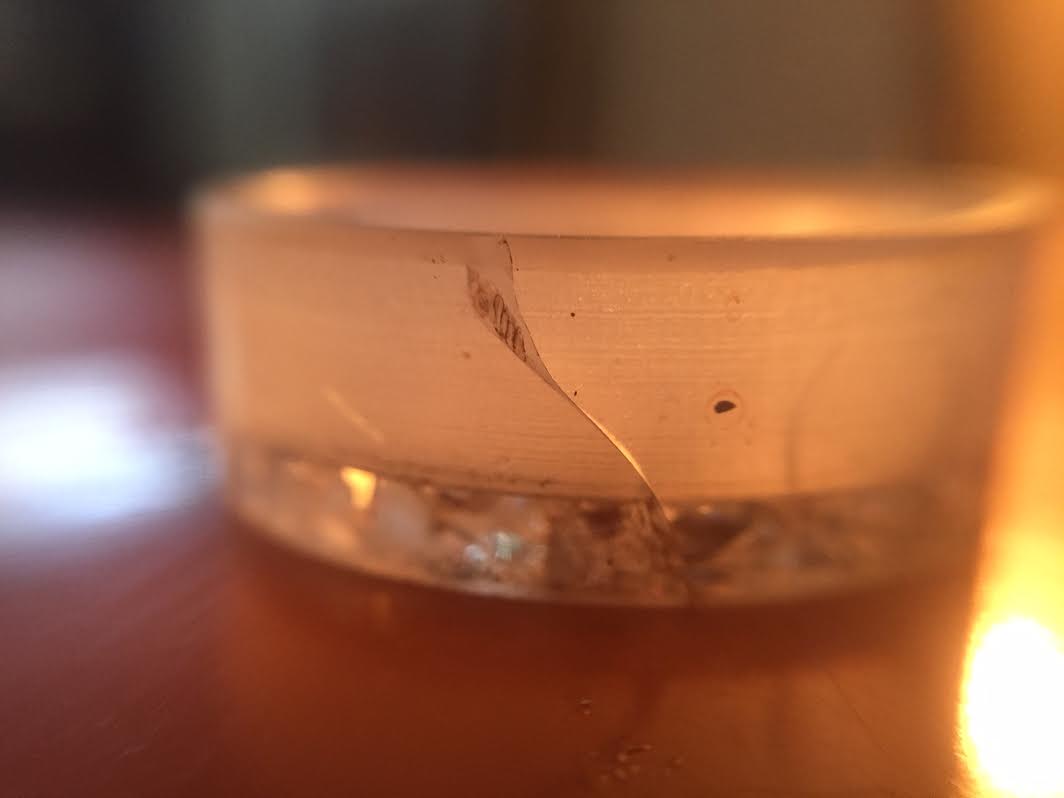81 Animal Cell Vs Plant Cell Organelles
Another difference between plant cells and animal cells is that animal cells can be all kinds of shapes and plant cells are usually boxy or rectangular. Endoplasmic Reticulum Smooth and Rough Present.
Venn Diagram Plant And Animal Cells Atkinsjewelry
Both plant and animal cells comprise membrane-bound organelles such as endoplasmic reticulum mitochondria the nucleus Golgi apparatus peroxisomes lysosomes.

Animal cell vs plant cell organelles. Chloroplasts and mitochondria have outer phospholipid bilayer membranes and circular DNA molecules like those of prokaryotic bacterial cells. Plant cells have chloroplasts because they make their own food. Plant and animal cells are both eukaryotic cells so they have several features in common such as the presence of a cell membrane and cell organelles like the.
Organelle Function Cell Membrane A double layer that supports and protects the cell. Model 3 Animal Cell vs. Lysosome Contains digestive enzymes that destroy damaged organelles and invaders.
Various organelles are present in both animal cells and plant cells whereas some are present in either of them. Some biologists believe that mitochondria and chloroplasts within eukaryotic animal and plant cells may have originated from ancient symbiotic bacteria that were once captured by other cells in the distant geologic past. Based on the table above it shows that both animal and plant cells have similar structure given the fact that they are eukaryotic cells.
It is obvious why animal cells lack in chloroplast as there is no process of photosynthesis that generates food for the cells - animal cells create their energy via different process. 24 rows The most striking difference between animal cells and plant cells is that plant cells. A most important difference between plant cell and animal cell is that animal cell does not have a cell wall whereas plant cell does have a cell wall.
Structure Of Animal And Plant Cell Download Scientific Diagram Both all animals and plants are made of cells. Endoplasmic Ereticulum ER Golgi Apparatus Vacuoles Vesicles Yes. Plant Cell Animal Cell Cell Membrane Plant Cell Vesicles Mitochondria Cell Wall Cell Membrane Nucleus Endoplasmi c Reticulum ER Nucleus Ribosomes Lysosomes Ribosomes Chloroplasts Cytoplasm Golgi Apparatus Mitochondria 16Do both cells in Model 3 have a nucleus.
Animal cells are mostly round and irregular in shape while plant cells have fixed rectangular shapes. Plant cell and animal cell differences plant cell vs animal cell Plants and. The most important structures of plant and animal cells are shown in the diagrams below which provide a clear illustration of how much these cells have in common.
They also have the same membranes cytoskeletal elements and cytosol. Cytoplasm Jelly-like fluid that surrounds and protects the organelles. Plant and animal cells.
Plant cells and animal cells both are eukaryotic cells that contain a nucleus and other organelles to perform necessary functions but the clear difference between them is the lack of cell wall vacuoles and chloroplast in the animal cell and the absence of flagella lysosomes and centrosomes in plant cells. Plant Cell vs Animal Cell. Animal cells dont have chloroplasts.
A plant cell usually has a single large and prominent vacuole which is a bladder-like structure containing water and other solutes thus serving as a storehouse of the cell. Nucleus The control center of the cell. Here are some of the main difference between animal cells and plant cells along with all functions and organelles and what role each one plays within the cell.
Animal cells may or may not contain one or many smaller vacuoles. They have membrane-bound organelles like the nucleus endoplasmic reticulum mitochondria lysosomes Golgi apparatus and peroxisomes. Allows materials in and out.
A cell is the basic unit of life. It is very rare. Contains the DNA Nuclear Membrane.
The primary difference from plant cells is that animal cells dont contain chloroplast nor structurally important cell walls. The plant cell can also be larger than the animal cell. This fascinating idea is called the Endosymbiont Theory or Endosymbiont Hypothesis for those who are more skeptical.
For example animal cells do not have a Cell Wall Chloroplasts or a Central Vacuole but plant cells do. Round irregular shape Rectangular fixed shape Chloroplast. What is the difference between plant and animal cel ls.
They also have similar membranes such as cytoskeletal elements and cytosol.
88 Vacuole Plant Or Animal Cell
Yes Plant cell have much larger vacuole than animal cell it occupies approx. A plant vacuole is a cavity within the cytoplasm which is covered by a single membrane and.

Difference Between Plant And Animal Cell Are Explained In Detail
It contain fluid called cell SAP which consists of water sugar amino acids in Science salt nitrogenous waste etc.

Vacuole plant or animal cell. Especially in protozoa single-celled eukaryotic organisms vacuoles are essential cytoplasmic organs organelles performing functions such as storage ingestion digestion excretion and. Its one of the largest organelles found in cells and its shaped like a large sac. The vacuole is a type of organelle present in eukaryotic cells.
The size of the animal vacuoles is relatively smaller as compared to the plant cell vacuole. These toxins keep animals and insects from eating plant material. In animal cells they are small and typically transport materials into and out of the cell.
Difference Between Plant and Animal Vacuoles Definition. In animal cells vacuoles tend to play a lesser role. Contains a liquid called cell sap which keeps the cell firm.
It is a sac surrounded by a single membrane called a tonoplast. They are surrounded by a thin membrane and filled with fluid and any molecules they take in. 7 rows Plant and animal cells.
This is the animal cell that has one or more vacuoles but the plant cell contains only one vacuole. Vacuoles serve many functions depending on the needs of the cell. Although animal cells contain vacuoles they do not contain large central vacuoles.
Cellcell wall a cell p label. Animal cell diagram labeled vacuole. Vacuoles have a simple structure.
Nucleus Transparent Animal Cell Vacuole In A Cell Diagram Free Transparent Clipart Clipartkey See vacuole stock video clips. Vacuoles are membrane-bound organelles that can be found in both animals and plants. In plant cells the large central vacuole is a membrane-bound organelle that functions to store waste products produced from cell metabolism.
Vacuole in biology a space within a cell that is empty of cytoplasm lined with a membrane and filled with fluid. In a way theyre specialized lysosomes. In animal cells these are typically smaller than in plant cells and help with waste removal.
50 - 90 of the cell volume. Plant vs animal cells diagram. These also include various materials like amino acids and sugars.
Some plant vacuoles store toxic substances which serve a defensive function. Difference between Cell Membrane and Cell Wall. Their cells have essentially deflated.
Vacuole Function in Animal Cells. Vacuoles in plant cells are essential for helping maintain water balance. A vacuole is a structure found in animal plant bacteria protist and fungi cells.
Initially the vacuole is like a small bubble. They are full of cell sap and provide turigdity and rigidity to plant. It becomes larger as the cell grows.
The one vacuole in the plant cells is larger in size and is. The main function of vacuoles in animal cells. Plant cells contain a single large vacuole.
In plant seeds vacuoles store proteins that germinating plants use to grow. This is why water-starved plants droop. Sometimes the waste product is water and therefore a vacuole would have as its function to maintain the balance of water inside and outside a cell.
Vacuoles are storage sacs or cavities in which solid or liquid is stored in the cell. The plant vacuole is the cavity present in the cytoplasm which contains cell sap while animal vacuole is the cavity in the cytoplasm that contains food and fluids. The contractile vacuole is a specialized type of vacuole.
The plant vacuole also contains water which functions. This diagram of a plant cell shows the central vacuole in blue. That is to say that their function is really to handle waste products and by handle mean take in waste products and also get rid of waste products.
Plant cell vacuoles serve the same vital storage functions for nutrients water and wastes as those in animal cells but are much larger because they also provide structural stiffness in combination with the plants cell walls.
28 Similarities Between Animal And Plant Cells
For example animal cells do not have a cell wall or chloroplasts but plant cells do. During Telophase animal cells have a contractile ring which is made of actin and myosin that forms halfway between the two nuclei in the dividing cell.

Similarities Between Plant And Animal Cells Biology Wise
Plant and animal cells both are surrounded by a cell membrane.

Similarities between animal and plant cells. Plant and animal cellshave several differences and similarities. Similarities In spite of the basic differences a plant cell and an animal cell have many parts and structures in common. Both have cell membrane cytoplasm nucleus ribosomes mitocho.
A plant cell is comparatively larger in size 10 to 100 micrometers whereas an animal cell is comparatively smaller in size 10 to 30 micrometers. Both animal and plant cells are eukaryotic. Animals and plants are two types of organisms with separate abilities.
Plant cells have cell walls and chloroplasts while animal cells do not. The cells of animals and plants possess many of the same structures. Animal and plant cells have some of the same cell components in common including a nucleus Golgi complex endoplasmic reticulum ribosomes mitochondria peroxisomes cytoskeleton and cell.
12 rows Similarities Between Plant and Animal Cells. Animal cells are mostly round and irregular in shape while plant cells have fixed rectangular shapes. Plant cells has a cell wall that provides support animal cell.
8th Jkbose The Cell Functions of organelles and similaritiesdifferences between Animal and Plant cell. 24 rows The animal cell and plant cell share many organelles in common such as a nucleus ER. Many similarities exist between plant and animal cells and they have three key differences as well.
Plant cells have chloroplasts for photosynthesis animal cells. The similarities found in cytokinesis in both plant and animal cells are only in the final result. The result of cytokinesis is the physical separation of the two daughter cells with identical.
In addition the contents of these cells are held together by cell membranes. For example plants can make their own food while animals depend on plants or other animals for food. Mentioned below is a list of.
Plant cells are more rectangular animal cells are more rounded. Plant and animal cells are both constructed from eukaryotic cells. Plant cells have large vacuoles while animal cells either have small ones or no vacuoles.
The plant cell can synthesize amino acids vitamins and coenzymes while the animal cell cannot synthesize amino acids vitamins and coenzymes. Both the cells contain membrane-bound organelles like the nucleus endoplasmic reticulum mitochondria Golgi lysosomes and peroxisomes. Meanwhile animals have a highly developed sensory system unlike plants.
Plant and animals cells have many of the same organelles such as the nucleus mitochondrion Golgi apparatus ribosomes and endoplasmic reticulum. 9 rows Many similarities exist between plant and animal cells and they have three key. Five Similarities between Plant and Animal Cells 1.
The primary cell organelles such as the nucleus mitochondria ribosomes etc are present in both types of cells. Since both the cells are eukaryotic in nature the plant cell and the animal cell have several behavioral similarities. Animal cells and plant cells are similar in that they are both eukaryotic cells.
In Plant cells a phragmoplast which is.
95+ Why Do My Nails Have Ridges And Cracks
Moisture can cause nails to become weak and brittle. This is most common in women over 60.

Sally Hansen Ultimate Nail Care For Winter November 2016 By Becreative Issuu
Nail clubbing is sometimes the result of low oxygen in the blood and could be a sign of various types of lung disease.

Why do my nails have ridges and cracks. Beaus lines are horizontal ridges caused by a serious health issue stroke heart attack etc. If your fingernails change color or you develop horizontal nail ridges across your nails talk to your doctor. As you can see in the photo of my naked nails above I got Beaus lines.
The nail itself becomes brittle making it easier to break bend or split. They are only present on my big toes and thumbs. You use your nails like handy little tools.
Vertical nail ridges If you have noticed raised lines on your nails which run from the tips right down to the cuticles then these are vertical ridges or longitudinal striations. Causes and symptoms of ridges in fingernails Fingernails are made by living skin cells in your fingers. The most common reason for cracked nails is something that happens to everyone.
Nail clubbing is also associated with inflammatory bowel disease cardiovascular disease liver disease and AIDS. Dark brown or black stripes down the length of the nail could be benign pigmentation moles or freckles. They can also be caused by a poor diet which Im guilty of.
This is usually temporary and will heal with time. If your diet lacks biotin-rich. So a skin condition such as eczema may lead to.
The ridges or lines on fingernails that appear often indicate something happening as the nail is forming or beneath it. Some nails become yellowed or dull and brittle and some or all may develop tiny longitudinal ridges. Nail trauma or a growth or tumor growing under the nail cause vertical ridges too.
They often become more numerous or prominent with age possibly due to variations in cell turnover within your nail. Damage to the nails through injury can cause ridges to develop. While protein deficiency is rare if your nails are peeling at the tips or showing lengthwise ridges both signs of brittleness biotin could help.
This compromise of oxygenated-rich blood and nutrients is why nails largely become brittle and possibly develop ridges she says. Many people with psoriasis experience problems with. Vertical nail ridges which are fairly common extend from the cuticle to the tip of your nail.
For example splinter hemorrhages are black length-wise lines that look like splinters but are most commonly due to trauma. The growth of fingernails and toenails slows as we get older and their appearance may change. As you age your nails become thinner and more likely to crack.
Long-term exposure can cause the skin around the nail to soften. Splitting cracked dry and brittle fingernails are a common problem for some people. When they are brittle and dry they wont stand up to the task and you will end up with splitting fingernails.
Anemia rheumatoid arthritis and peripheral vascular disease may also increase your risk for fingernail ridges. The problem gets worse as we age and our skin hair and nails become more prone to dryness. Fingernails tend to become thinner and more fragile while toenails.
In rare cases a nail ridge can be.

